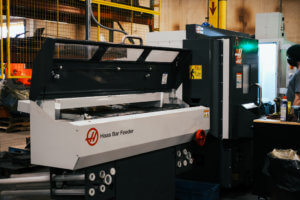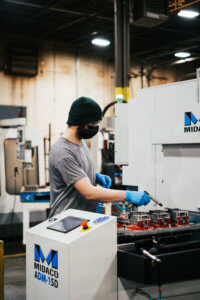How to Integrate Automation into Your Manufacturing and Fabrication Business
June 22, 2022
How to integrate automation into your manufacturing and fabrication business
There is no question about it. Automation can make a dramatic difference in the productivity of a manufacturing company. But is it for everyone? How do you know where to start? What are some of the pitfalls? In this article, we will outline the process we have used at Laser Precision to successfully add automation to our own operations, and offer some suggestions that might be helpful.
Does Automation Make Sense?
 The obvious place to start is on the shop floor. The decision whether to add automation should be driven not only by the work mix, but the individual parts you turn out. There are a lot of variables, such as tolerances, material type (how it interacts with machine), part size, part weight, ease of changeover and interference issues.
The obvious place to start is on the shop floor. The decision whether to add automation should be driven not only by the work mix, but the individual parts you turn out. There are a lot of variables, such as tolerances, material type (how it interacts with machine), part size, part weight, ease of changeover and interference issues.
Determine what equipment on the line is doing the heavy lifting and where the bottlenecks are in the flow. Would automation alleviate the chokepoints? For example, if most of your work is done on a press brake with tight tolerances, robotics may not be the best solution.
The physical dimensions of the workspace should also be taken into consideration. Is there enough room to add automation equipment where it will produce the most value? And if you’re in an HMLV environment, will the automation you choose allow you to easily change over jobs?
Establish Goals
Once you decide which processes are likely to benefit from automation, establish what exactly it is you want to accomplish. For instance, eliminating a repetitive and time-consuming process or running a third shift. Which type of automation is most likely to help you achieve those goals? Are you looking for a fully automatic cell which delivers a complete product without human intervention, or a collaborative approach with cobots and operators working together?
An effective way to arrive at goals is to ask yourself: “Where will the dollars come from for ROI?” The answer usually can be found in one of two areas: labor savings or increased throughput. For example, a group of automated laser cutters with an integrated material rack system can be managed by one operator. From a throughput standpoint, these machines can run 24 hours a day. The extra hours pay back the investment faster. From a labor perspective, the workers who loaded the laser pallet-by-pallet can be reassigned to other duties.
Find Resources
 The next step is to start conversations with industry experts (typically equipment manufacturers or integrators) to investigate automation systems that are available to you. They can be extremely helpful. Discuss your equipment, challenges and goals in depth. These specialists can often advise you whether your plan is workable or too complex for your needs.
The next step is to start conversations with industry experts (typically equipment manufacturers or integrators) to investigate automation systems that are available to you. They can be extremely helpful. Discuss your equipment, challenges and goals in depth. These specialists can often advise you whether your plan is workable or too complex for your needs.
Then again, you may see applications on demo showrooms that seem terrific, but don’t quite match up with your unique real-world situation. Sometimes you’ll get a more realistic perspective from someone who’s gone through a similar project instead of a salesman’s point of view. Use networking to obtain references for businesses that purchased automation similar to the types you’re thinking of investing in. Visit those shops. Ask questions on their approach and request details about any problems they might have had in integrating the hardware.
Educate the Workforce

When you’ve done your homework and are ready to buy, it is vital to share your goals with the personnel in your shop. Workers often see automation as a threat to their jobs. If an asset allows you to cut back on the labor necessary to undertake a function, that is value-added. It’s important to point out that this does not mean jobs are to be eliminated but redistributed for maximum efficiency.
Automation may also bring in diverse types of work and higher volume jobs. A positive balance sheet means job security for everyone.
Building a Foolproof Process
Make sure to take the time to develop the programs needed to run the automation hardware. Automation means you won’t have a person watching the machine full time. Spot checks are necessary for quality control, tool wear, etc. There is no profit to be made from coming in for the morning shift and finding the night’s run is scrap due to a worn tool. It is important to rely on your equipment and tooling manufacturers. They need to be capable, careful and focused in on your needs, from program design down to inspection.
Final Thoughts
Automation can be a great way to expand your business. Taking the time to carefully evaluate your needs and expectations will supply a solid foundation so that your investment will pay dividends across the shop floor.



